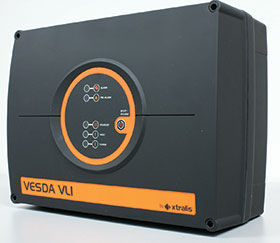

The Centa Group keeps abreast with international standards in all sectors, including industrial fire detection. Centa’s range encompasses a recently launched VESDA VLI early warning aspirating smoke detection (ASD) system, designed to protect industrial applications and harsh environments (Class 1 Div 2 applications) up to 2000 m².
“Reliable smoke detection in industrial applications can be a challenge because of various factors that include background pollution, smoke and airborne particles, extreme temperatures and plant wash down influences,” says Duncan Boyes, chairman of the Centa Group. “With the launch of the new VESDA VLI early warning aspirating smoke detection system, which is manufactured by Xtralis, Centa prevents disasters by ensuring total reliability of very early smoke detection.
“This smoke detection system detects the earliest presence of fire, ensuring there is sufficient time – especially in an industrial situation – to prevent devastation to lives, property, products and equipment. VESDA VLI is designed to reduce risk, prevent product loss and minimise downtime.”
This system operates on the principle where air is continually drawn through the pipe network and into the VLI detector by a high efficiency aspirator. The air sample passes four sets of ultrasonic flow sensors before being passed through the intelligent filter.
This intelligent filter incorporates a flow splitting arrangement, where a smaller unfiltered portion of the sample is passed through another set of ultrasonic flow sensors and a larger portion of the sample passes through a high efficiency particulate air (HEPA) filtration medium. This design reduces the amount of contaminants entering the aspirator and detection chamber which extends service life of the detector in harsh and polluted environments.
This intelligent filter, which is fully monitored, provides consistent sensitivity during the operational life of the detector. This is achieved by comparing readings from the ultrasonic flow sensors at the detector air inlets, to readings from the unfiltered path and measuring the split of the airflow ratio as the filter load changes.
The filtered and unfiltered air samples are recombined as they exit the intelligent filter. A portion of the recombined sample is then passed through the sub-sampling probe and a secondary filter. This configuration prevents larger dust particles from passing through the probe and filter arrangement, thus eliminating nuisance alarms.
A third filter within the detection chamber assembly delivers a clean air barrier which protects the optical surfaces from contamination, further extending detector life and ensuring absolute calibration.
The detection chamber has a stable, highly efficient laser light source and sensor configuration to achieve optimum response to a wide range of smoke types. The presence of smoke in the detection chamber creates light scattering which is detected by the highly sensitive sensor circuitry, which then activates an alarm signal.
The VLI detector is less susceptible to nuisance alarms because of the intelligent filter, the lint trap which captures fibrous particulates, a sub-sampling probe that acts as an inertial separator and a secondary filter. A ‘Clean Air Zero’ facility is a user initiated feature which safeguards against nuisance alarms. This is achieved by introducing clean air into the detection chamber and taking a reference reading, This reading is then offset against the actual environment background to maintain consistent absolute smoke detection.
The VLI detector is equipped with a powerful aspirator which provides a total pipe length of 360 m. This system is supported by Xtralis software, which facilitates efficient pipework design, system commissioning and maintenance, as well as compatibility with existing VESDA installations. This system has an index protection (IP) 54 rating for protection against dust ingress and water in all directions. In most applications, this eliminates the need for costly enclosures, thus simplifying and reducing installation costs.
This new VESDA system has been designed with field replaceable parts for easy maintenance and cost efficiency. For optimum control of the system, the status of the detector, alarms, service and faults events is monitored and logged with time and dates.
For more information contact The Centa Group, +27 (0)31 569 1175, centa@centa.co.za, www.centa.co.za

© Technews Publishing (Pty) Ltd. | All Rights Reserved.